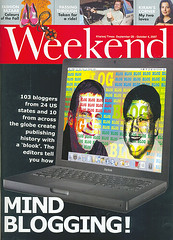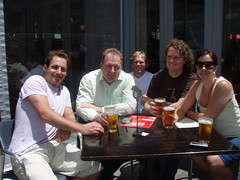 Years ago, when I was studying performance and movement we were given small, concentrated workshop tasks. One of the most difficult was the be "happy". Despite how this sounds, it is not a simple exercise (as anyone who has seen the word "happy" in a brief will understand). First, I would start with my breathing, emptying myself of breath and then slowly inflating myself. Next I would lift my posture, straighten my spine and raise my head. I would imagine and feel the way that my breath would inhabit the far recesses of my body … reaching to my fingertips and out to my eyelashes. Sometimes I would smile, othertimes, not. But time and again I would find that my "happy" would not quite make it … it would fall short somewhere … somewhere short of "being" or "embodying".
Years ago, when I was studying performance and movement we were given small, concentrated workshop tasks. One of the most difficult was the be "happy". Despite how this sounds, it is not a simple exercise (as anyone who has seen the word "happy" in a brief will understand). First, I would start with my breathing, emptying myself of breath and then slowly inflating myself. Next I would lift my posture, straighten my spine and raise my head. I would imagine and feel the way that my breath would inhabit the far recesses of my body … reaching to my fingertips and out to my eyelashes. Sometimes I would smile, othertimes, not. But time and again I would find that my "happy" would not quite make it … it would fall short somewhere … somewhere short of "being" or "embodying".
My teacher, the lovely and quite scary, Leisa Shelton, would always want more … would want us to push this small performance closer to life — so that the distinction between the performer and the performed would collapse. While I could intellectually understand this, I found it was difficult to achieve in practice. You see, there is a vast difference between the way that you will experience something and the way that another person will perceive it — especially in performance. In performance, the body needs to appear 25% larger to give the impression of being 100% real (this was the realisation of Leisa’s teacher, Etienne Decroux while observing Rodin’s The Thinker) … these days I am always drawn to images of happiness (hence the image here courtesy of Suzanne G).
But, take a look at this challenge for a second. What does it mean to be 125% more real when translated into digital identity? What does this mean for digital storytelling … and perhaps, most importantly of all, what does this mean for personal brands and naming? Jeff Pulver has been looking at the intersection of names and personal branding for the last couple of days and is convinced of the need to have a single name across all of our social media haunts. But, apart from the challenges of having a unique name (luckily I don’t think there are too many Gavin Heatons in the world), is it necessary or is it even desirable?
I have had a connection to the digital identity "servantofchaos" for many years now, and one of the things I like about it is its potential. For example, servantofchaos has the opportunity of being 125% Gavin Heaton — it can be an oversized version of my own self, multiplied and amplified by the digital array and power of the network. It can also serve as the persona through which I can project and connect to the world in a way that my personal traits, inhibitions or even time restrictions can prohibit.
When I first started this blog and began commenting on others, I did so under the name servantofchaos. And while I no longer feel the need to do so (or have the desire to play with the identity), after all this time, I would be reticent to relinquish it completely. It has become something more than just a name … I have, in a sense, embodied it. What do you think?

 Years ago, when I was studying performance and movement we were given small, concentrated workshop tasks. One of the most difficult was the be "happy". Despite how this sounds, it is not a simple exercise (as anyone who has seen the word "happy" in a brief will understand). First, I would start with my breathing, emptying myself of breath and then slowly inflating myself. Next I would lift my posture, straighten my spine and raise my head. I would imagine and feel the way that my breath would inhabit the far recesses of my body … reaching to my fingertips and out to my eyelashes. Sometimes I would smile, othertimes, not. But time and again I would find that my "happy" would not quite make it … it would fall short somewhere … somewhere short of "being" or "embodying".
Years ago, when I was studying performance and movement we were given small, concentrated workshop tasks. One of the most difficult was the be "happy". Despite how this sounds, it is not a simple exercise (as anyone who has seen the word "happy" in a brief will understand). First, I would start with my breathing, emptying myself of breath and then slowly inflating myself. Next I would lift my posture, straighten my spine and raise my head. I would imagine and feel the way that my breath would inhabit the far recesses of my body … reaching to my fingertips and out to my eyelashes. Sometimes I would smile, othertimes, not. But time and again I would find that my "happy" would not quite make it … it would fall short somewhere … somewhere short of "being" or "embodying".




